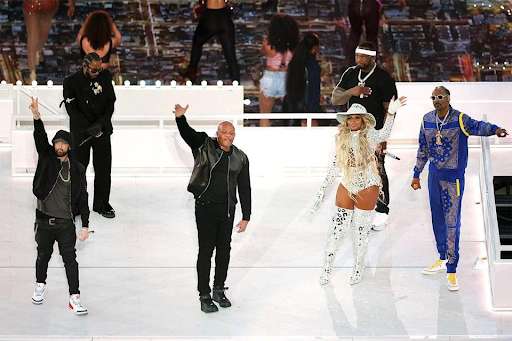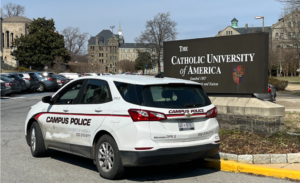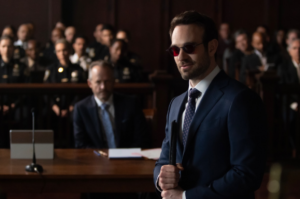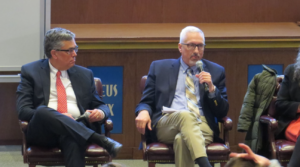Super Bowl LVI Halftime Show Recap: Big Names, Big Presentation, Poor Execution

Image Courtesy of Gregory Shamus / Getty
By Joey Brasco
Super Bowl LVI’s Halftime Show performance, with its bloated lineup of five artists, was a prime example of too much of a good thing. Trying to incorporate performances from five music legends, all with incredibly prolific catalogs, into a 15-minute performance was bound to be challenging.
The show, held in SoFi Stadium, set itself up to be an ode to California, a logical theme given that headliner Dr. Dre is largely responsible for the “g-funk” sound that defined West Coast hip-hop in the ‘90s.
Adding to the Cali vibe was Dre’s longtime collaborator Snoop Dogg, who is featured on many of Dre’s biggest songs.
Rounding out the West Coast trifecta was Kendrick Lamar, who, despite being almost two decades younger than the former artists, has carved out a musical track record that stands toe-to-toe with any of the other legends on stage.
The show started out promisingly, as Dre emerged from beneath a stage made to look like a pearly white recording studio, playing into the narrative that he is orchestrating the whole event.
The grand entrance leads into a solid performance of “The Next Episode,” by Dr. Dre which features a verse from Snoop. Though other bits of the show suffers from a lack of studio magic, the instrumental of this track delivered a grand backdrop for the live setting.
Snoop Dogg made the most of his moment, displaying his laid-back charisma as he casually delivered his raps and some very nimble dance moves; his joint mobility was not indicative of his age. No pun intended.
Seeing as they were in SoFi Stadium, Dre and Snoop delivered an apt performance of “California Love,” a track by Dre and the late-great Tupac Shakur, another California legend.
Up to this point, the show was running smoothly, but then went down, literally, as Dre and Snoop motioned down to reveal the surprise appearance of an upside down 50 Cent, which was done in reference to his iconic “In Da Club” music video.
Surrounded by an array of dancers, he performed “In Da Club” as he mumbled his way through a censored version of the track. His inclusion was memorable, but more for how it resembled someone’s dad doing awkward karaoke rather than being a great performance. To be fair, he may have been flustered by all of the provocative dancers swarming him.
Around this time in the show, a lack of cohesion became apparent when 50, a New York Native, had his performance followed by another New Yorker, Mary J. Blige, both of whom performed on a purely California-decorated stage.
Blige delivered a far superior performance to 50, however, performing her song “Family Affair,” as well as “No More Drama.” Her powerful and emotive voice overcame the challenges presented by the lackluster mixing on the rapper’s vocals. Her songs also offered the added bonus of not relying on profane lyrical content, which allowed her performance to run smoothly compared to the self-censored renditions of the other tracks. She ended her routine by slapping her head repeatedly in exasperation before flopping backward. As far as we know, she is currently doing alright following this display.
The censoring issue was most apparent for Kendrick Lamar, who, in general, was given the short end of the stick in this setlist. It cannot be understated just how spectacular and groundbreaking Kendrick’s music is, and his appearance being jammed into this giant mashup will make many pine for an alternate reality in which he was given his own show. Still, his energy is unmatched, and being able to see him in action is a welcome sight after his long hiatus from music.
He entered with his backup dancer by popping out of a box labeled “Dre Day” as he performed a short interlude of his fantastically raw “m.A.A.d. city,” from his masterful sophomore album Good Kid, M.A.A.D City. The track was perhaps a little too raw for this setting, though, as the censoring butchers the flow of the chorus for those who know the original version of the song.
Kendrick then moved into a performance of the anthemic “Alright,” where censoring once again reared its ugly head. The song’s lyrical content is meant to paint a picture of surviving amidst a broken world filled with persecution and suffering. This message of hope amidst the pain is missed when the originals powerful mantra of “I’m f****d up / homie you f****d up, but if God got us then we gon’ be alright!” is now replaced with the meaningless, “I’m on one / homie you on one.” This moment was a disappointing reminder of how censorship can neuter great art.
Even more frustrating was the missed opportunity for Kendrick to perform one of his songs that featured any of the other headlining artists that were present at the show. Notably, his catalog includes the California anthem “Compton,” featuring Dre, as well as the beautifully uplifting “Now Or Never,” with Blige, which has the added bonus of being a completely clean track.
Kendrick then delivered a disorganized freestyle that served as a segue to introduce the best selling hip-hop artist of all time, Detroit native, Eminem.
He entered with a clumsily performed snippet of his classic Dr. Dre collaboration, “Forgot About Dre,” where he failed to keep pace with the flow of the backing track, a rare misstep for the self-proclaimed “rap god.”
He redeemed himself with a performance of his iconic “Lose Yourself.” Other than Dre and Snoop’s rendition of “California Love,” “Lose Yourself,” was the only other song that meshed seamlessly with the grandiose nature of this event. His performance was solid enough, but the live iterations of these songs greatly paled in comparison to their studio recorded counterparts. Unique to this version of the song was the inclusion of California native Anderson .Paak playing the drums live. His inclusion, unlike 50 Cent’s appearance, was consistent with the Cali-theme.
The show ended with a grand conclusion, as the iconic piano melody of Dre’s “Still Dre” played as the artists all gathered center stage.
This halftime show promised a big production headed by big names, and, in that sense, it delivered. The stage was grand, and it was energizing to see all of these great talents standing tall as the crowd roared in adulation following their performance. However, when you take a step back from all of the glitz and glamor, it was clear that this show suffered from too much of a good thing. There were just too many artists present here for everyone to get the time to shine that they all deserved.







